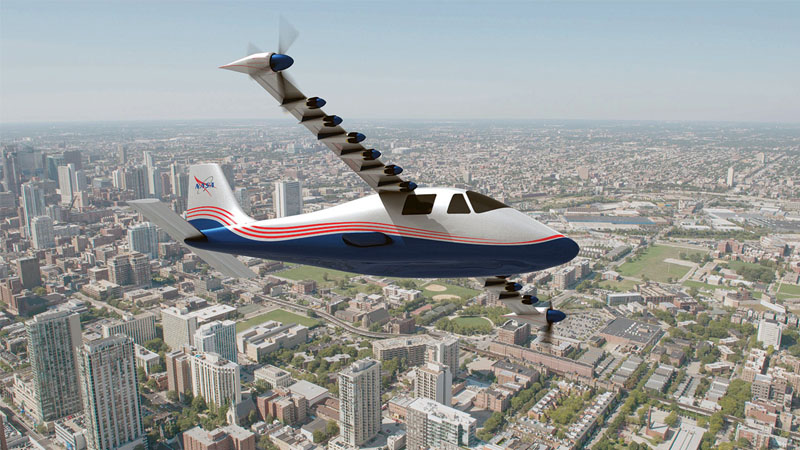Stay Up to Date
Submit your email address to receive the latest industry and Aerospace America news.
Safer battery modules required for 2018 flights
NASA in September expects to test redesigned lithium ion battery modules for its X-57 Maxwell electric plane to see if they can function safely even if one of the cells inside them overheats. The tests will be one of the hurdles the agency must clear before reviewing the piloted experimental plane’s readiness to start flying in early 2018.
The X-57 team aims to demonstrate electric propulsion under the agency’s New Aviation Horizons initiative, which has the broad goal of revolutionizing passenger travel. The plane’s final configuration will consist of 14 electrically driven propellers distributed across its wing, which is specifically designed to accommodate them and deliver maximum efficiency. NASA expects this design to make the X-57 five times more energy efficient during high-altitude cruising than a combustion-driven plane of the same size. Plus, the X-57 will be quieter than a gas-powered plane and produce no carbon emissions. The plane will be powered by 16 battery modules that hold hundreds of lithium ion battery cells, each comparable to the size of a AA battery.
NASA and a contractor redesigned the packaging for the electric motor’s lithium ion batteries after a December power test resulted in a thermal runaway event in which heat spread from one cell to the next. Electric Power Systems of Utah worked with battery experts at NASA’s Glenn Research Center in Ohio and Johnson Space Center in Houston on the redesigned modules. The company provided the modules as a subcontractor to prime contractor, Empirical Systems Aerospace of California. Tests of the new design will be done at an Electric Power Systems lab in Logan, Utah.
During a December test, one cell was intentionally overheated in a battery module, which caused the rest of the module to overheat and spurred the team to redesign the packaging. Each module will now have a “honeycomb block” of aluminum holding individual cells. This should provide enough space among battery cells to keep them from overheating. Initial data indicates that a repeat of the December exercise will prove that the new design will prevent a thermal runaway, says Matt Redifer, chief engineer for the X-57 project at NASA’s Armstrong Flight Research Center in Palmdale, California. The plane will also now have 16 battery modules instead of eight to provide more space among the cells, says Sean Clarke, NASA’s principal investigator for the X-57, in an email.
The redesigned battery modules will add 45 kilograms to the plane, but Redifer says that was a necessary concession to safety, despite the desire to limit the weight of the plane. “The battery is a means to an end,” Redifer says, rather than an area where the X-57 team is trying innovate. “Our battery is heavier and probably lower energy density than you might get out of, say, a Tesla [electric car lithium ion] battery.”
If all goes well with tests of the modules and other components, the flight readiness review will begin “in the fall,” or no earlier than September, Redifer says. Pilots and engineers have been flying a simulator of the X-57 at NASA Armstrong to prepare for the flights.
NASA chose a twin-engine P2006T built by Italy-based Tecnam as the foundation for the X-57. Engineers have removed the plane’s existing wing and combustion engines and are replacing them with the new wing and propellers. Managers plan to compare data from the X-plane with the performance of its unmodified counterpart.
The real engineering feat of the X-57, rather than safe battery packs, is designing the smaller, distributed electric propulsion wing for its fuselage with propellers that can provide better lift at low speeds compared with the original Tecnam model, says Mark Moore, NASA’s former principal investigator of the X-57. Moore joined Uber in February as its engineering director of aviation after spending 32 years at NASA to help the company work with other firms to make electric aircraft ride-sharing a reality.
About Tom Risen
As our staff reporter from 2017-2018, Tom covered breaking news and wrote features. He has reported for U.S. News & World Report, Slate and Atlantic Media.
Related Posts
Stay Up to Date
Submit your email address to receive the latest industry and Aerospace America news.





